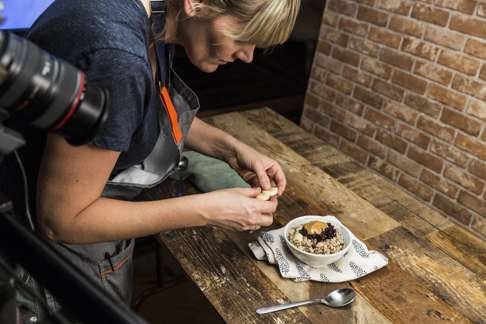
How short cooking videos took over the web and are about to surpass television
Video sites such as Tastemade and Buzzfeed’s Tasty are racking up hundreds of millions of views per month and earning billions of advertising dollars
With the solemnity of a priest, Tastemade programming chief Oren Katzeff paces near his TV-grade studio kitchen and assesses his media giant’s latest creation: apple-pie latkes, baked on camera for five seconds of Snapchat fame.
In four years, his video network has transformed food porn designed for digital natives into a global juggernaut. But the competition is fierce – and the demands are endless – if he wants Tastemade to stay one of the most-watched media empires on the web.
“There is something about being maniacal, right?” Katzeff says outside the soundstage during one of the day’s half-dozen recipe shoots. “We are so laser-focused on all this stuff. We don’t sleep that much.”
Short, viral videos have become more than digital-age curiosities. They are a central economy of the web and a serious business on which future media fortunes will be gambled, won and lost.
Pumped out cheaply and quickly, most web and mobile videos make a fraction of the money of a Hollywood film. But they also carry a fraction of the risk: for their makers, a flop doesn’t break the bank – and a hit can mean everything.
“In terms of eyeballs and time spent, there’s an increasing war for your time and attention,” says Rich Greenfield, a media analyst with investment firm BTIG.
“Web video, mobile video, is still in its infancy, but I wouldn’t mistake being early for being wrong. In 1980, basic cable was really early, too.”
Web video’s rise has sparked a growing tension for media’s most established players, who must retool and compete for a new generation of viewers on an increasingly insatiable internet.
In June, Facebook called video “the best way to tell stories in this world” and said that the world’s biggest social network, with 1.6 billion users, would be “probably all video” within five years.
The players are fighting over billions of screens in people’s pockets, where advertisers are moving en masse.
Spending on digital ads in the United States is expected to surpass TV ads this year for the first time, according to research firm eMarketer. Web-video ad spending grew to US$10 billion this year, having doubled since 2014.

Producers, networks and news organisations have been racing to publish more videos, because advertisers will pay more to sponsor them than digital offerings such as banner ads.
The companies on web video’s front lines do not have the reliable channel placement, traditional audiences or big commercial payouts of TV’s goliaths. Many, including Tastemade, are not profitable or keep their revenue under wraps.
Yet their growth has been enough to encourage alliances that a few years ago would have seemed far-fetched. In December, Tastemade secured US$40 million in investments led by Goldman Sachs. Backers included the venture arm of Comcast, the world’s biggest cable company, as well as TV giant Scripps Networks, owner of the Food Network.

Many of the old hallmarks of television craft don’t apply. Celebrity cameos, high production values and long stories are out, while colourful sets, simple ideas and short, “snackable” moments are in.
The videos are built to go viral, not to win awards, so volume is paramount, and long-accepted signatures of traditional video are ignored. Many videos are shot vertically to fit how younger viewers see the world: through phone screens. The sound is deemed less important; many viewers watch them muted, anyway.
On Facebook, Tastemade has become an unstoppable force, with more “likes” from loyal subscribers than The New York Times and Washington Post combined. Even so, Tastemade is a traffic underdog to Tasty, BuzzFeed’s competing food-video giant.
In August, Tastemade was added to Snapchat’s top media-company line-up, Discover, putting it a swipe and a tap away from every user on one of the fastest-growing social apps on the planet. Coca-Cola was one of the firm’s first sponsors.
Founders Steven Kydd, Joe Perez and Larry Fitzgibbon launched the network in 2012 after meeting at Demand Media, a web “content farm” whose business depends on getting clicks from Google searches. But within three years, Tastemade had become one of the rare additions to Snapchat’s heavy-hitters list that was not a household name.
While web video has not supplanted the titans of TV and film (yet), its early successes have shown what kinds of content resonate on an always-on platform free from traditional length, style and cost constraints.
“TV has all the money, and the TV ecosystem has an older consumer,”says Laura Martin, a senior analyst at Needham. “But the data you can get online – on younger audiences, short-form programming – is really important, too. [They can show] how certain verticals are making it work.”
To cash in, web-video giants still rely on TV’s classic moneymakers, including riffs on product placement and regularly scheduled commercial breaks.
Tastemade’s revenue has come from “brand integrations” with corporate sponsors, including Google, Grey Goose and REI, some of whose executives say they have paid “seven figures plus” to insert their products onscreen. Hyundai sponsored a pork-and-pigskin feature, “The Grill Iron,” that programming chief Katzeff defined as “auto meets college football meets tailgating, but not in a ‘bro’ sort of way.”
The executives acknowledge the natural tension between a hip, web-friendly food network seeking to expand into a corporate trough. But they say they offer advertisers an irresistible deal: young viewers bored by or disinterested in the behemoth of primetime TV.
“The audience that’s not watching TV, the audience that’s not watching commercials,” Katzeff says, “is the audience that’s looking at Tastemade content every day.”

